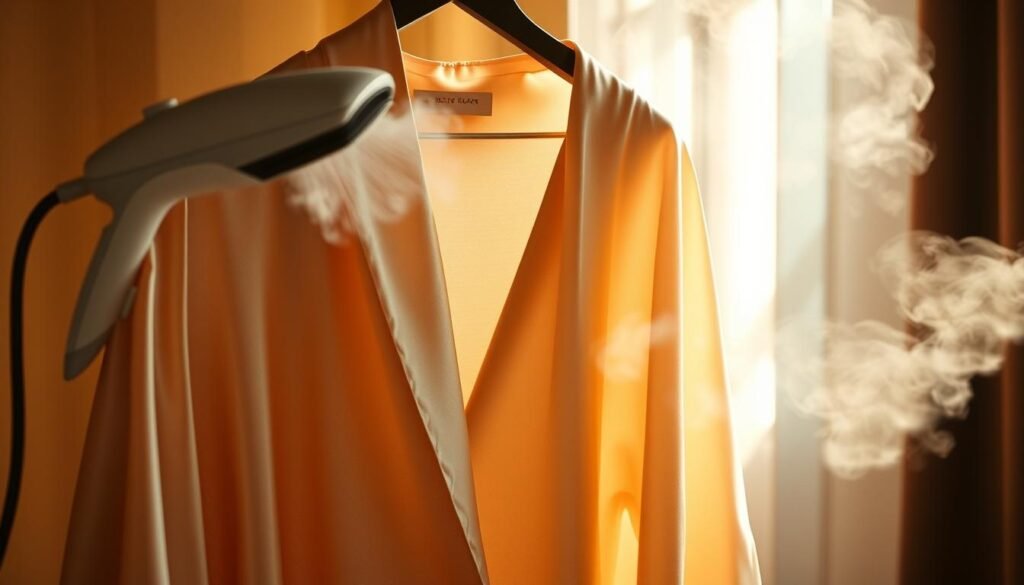Is steaming silk fabric safe and effective, or is it risky? Silk is known for its luxurious feel and elegant look1. We’ll show you how to steam silk fabrics right. This guide will teach you to keep your silk looking great while getting rid of wrinkles easily.
Key Takeaways
- Steaming is a gentle way to remove wrinkles from silk without harming the fibers.
- It’s important to take good care of silk because it can get damaged by high heat and rough handling.
- Steaming is a safer choice than ironing for silk clothes, keeping their shine and beauty.
- 1 Satin fabrics, like silk satin and polyester satin, can be steamed well with these tips.
- 2 Steaming satin is fast and easy for getting rid of wrinkles, usually taking just a few minutes.
The Importance of Proper Silk Care
Silk is a delicate and luxurious fabric that needs special care to stay vibrant and last long3. It’s seen as an investment because it’s durable and can last a long time. Taking good care of it can save you money and help your skin too3. But, silk can get damaged by high heat, harsh chemicals, and wrong handling3.
Understanding Silk’s Delicate Nature
Silk is a natural protein fiber that can be easily harmed by some things3. Bleach can ruin silk clothes right away, making the fibers break down3. Also, too much sunlight can change the silk’s protein structure, making it lose its silky look3. It’s important to wash and store silk clothes the right way to keep them looking good.
Benefits of Steaming Over Traditional Ironing
Ironing can be bad for silk because it uses too much heat, which can hurt the delicate fibers3. Steaming is gentler and works better for getting rid of wrinkles, keeping the silk shiny3. If you must iron silk, use low heat and put a cloth between the iron and the silk3.
Knowing how delicate silk is and using the right care, like steaming instead of ironing, helps keep your silk looking great3. Taking good care of silk is key to getting the most out of this luxury item3.
Preparing Your Steamer for Silk Fabrics
Choosing the right steamer is key for steaming delicate silk fabrics4. There are many types, like upright models for home use and handheld ones for travel. Make sure to pick a steamer with settings safe for silk4.
Selecting the Right Steamer
For silk, get a steamer with adjustable heat4. This lets you avoid wrinkles without harming the fabric. Also, think about the water tank size. A big tank means less refilling during steaming4.
Filling the Water Tank
After picking your steamer, fill it with water4. Use soft or distilled water to protect your silk. Hard water can leave spots or damage the fabric4.
Choosing the right steamer and water makes steaming silk easy4. Prepping your steamer right means a smooth silk steaming experience4.
Step-by-Step Guide to Steaming Silk
Steaming silk is a gentle way to remove wrinkles. Start by hanging your silk near a doorframe or curtain rod. This makes it easy to move the steamer around the fabric5.
Steaming Techniques for Silk
Use a gentle, downward motion with the steamer on silk. Keep the steamer 1-2 inches away from the fabric. This relaxes the fibers and smooths out wrinkles without damage5. Work in sections and cover the whole garment6.
Keep the fabric taut as you steam it. Stretch the silk as you go to lift and smooth out wrinkles. With practice, you’ll get great results6.

Steaming takes 5 to 15 minutes, depending on the garment’s size and complexity5. Be patient for a smooth finish. With the right techniques, your silk will look great6.
“Steaming is a game-changer for maintaining the luxurious look and feel of silk fabrics. It’s a gentle, effective way to remove wrinkles without compromising the delicate fibers.”
Follow these steps to get good at steaming silk. It’s important for keeping your silk looking vibrant and soft56.
Discover the joys of customsilk and learn how steaming can keep them looking their best.
Can You Steam Silk Fabric? A Complete Guide
Steaming is now a top choice for caring for delicate silk fabrics instead of ironing. Satin, a silk relative, can be made from many materials like cotton, wool, and silk7. Steaming is a soft way to get rid of wrinkles in satin without losing its softness and shine7.
Steaming silk at home is easy. Keep the steamer 1 to 2 inches away from the silk to keep its quality8. Let the silk dry in the air after steaming to keep its shine and avoid water marks7.
Ironing silk needs special steps. Turn the garment inside out and use a pressing cloth. Iron it with a low heat setting8. Silk should be ironed at 300°F, which is cooler than for synthetic or natural fibers9.
Steaming is a safe and good way to care for silk. With the right steps, you can keep your silk items looking great. Always check the care label and use a gentle touch. For delicate silk, consider getting professional cleaning.
Troubleshooting Common Steaming Issues
Steaming silk fabrics is delicate and requires care to avoid damage10. It’s best for silk, cotton, cashmere, and other delicate items that wrinkle easily10. Use irons for thick fabrics like denim and linen10. Don’t use steamers on fabrics that say ‘do not wash’ or ‘dry clean only’10.
Preventing Water Spots and Damage
Steaming silk can cause water spots or damage11. Satin silk is especially sensitive to marks and creases11. Keep the steamer away from the fabric and clean the steamer head often10. Steam the inside of garments if needed10. Sometimes, steaming multiple times is needed for tough wrinkles10.
10 Use filtered water to avoid steamer clogs. Many steamers, like the Beautural Portable Handheld Steamer, offer features for safe steaming of silk10.
12 Silk must be at least 95% silk to be pure silk12. Silk blends have 20-50% silk content12. Silk loses up to 20% of its strength when wet12. Dry cleaning is often needed for silk maintenance12. Handling silk wrong during cleaning can damage it12. Tumble drying silk can also harm it.
12 Steaming safely removes wrinkles from silk12. Ironing silk on low heat with a cloth is also safe12. Sunlight and heat can damage silk. A mix of vinegar and water can restore silk’s shine12.
Steaming Silk Garments vs. Other Fabrics
Steaming silk is different from steaming other materials. Silk is a delicate fiber that can get damaged by too much heat and water13. Steaming silk uses gentle steam to smooth it out. This way, it avoids water stains and permanent creases13.
Choosing the right steamer is key for silk. Look for adjustable steam levels, wide steam heads, and non-stick soleplates13. Use distilled water and start with low steam to test on hidden spots first13.
| Fabric Type | Steaming vs. Ironing |
|---|---|
| Silk | Steaming is gentler, avoiding the heat and pressure of ironing. This can cause discoloration, shrinkage, and weaken fibers13. |
| Satin | Steaming works well for satin, like blouses and dresses. It removes wrinkles without losing the fabric’s smooth look14. |
| Synthetic Fabrics | Synthetic materials like polyester are less wrinkly. Ironing them can make creases sharper15. |
| Natural Fabrics | Natural fabrics with a nap, like corduroy, benefit from gentle steaming. It keeps their natural look and feel15. |
Steaming techniques vary by fabric type. Adjusting the process for each material is key. Understanding how to steam silk right keeps your garments looking luxurious131415.

“Steaming is a game-changer for delicate fabrics like silk, allowing you to smooth and refresh them without the risk of damage that can come with traditional ironing.”
Tips for Maintaining Silk’s Luster and Sheen
Proper Storage and Care After Steaming
Keeping silk fabrics looking great needs careful attention, even after steaming. Here are some key tips to keep silk’s shine:
- Let the silk garment cool on a padded or thick wooden hanger before storing. This step stops wrinkles from coming back16.
- Put silk items in cotton bags or boxes that breathe. This keeps them safe from dust and humidity17.
- Use a special silk and wool detergent when washing silk. Regular detergents can be too strong. Wash it on a gentle cycle with cool to warm water17.
- For a deep clean, think about dry cleaning with gentle solvents like Siloxane-based cleaners. This keeps the silk in good shape17.
- After drying silk, gently squeeze out water without twisting or wringing. Lay it flat on a towel and reshape it. Then, let it air dry in the shade17.
By using these easy storage and care tips, your silk clothes will stay beautiful and elegant. They will keep their shine for many years.
Remember, taking good care of your silk is important. With a bit of extra effort, your silk will look and feel great after many steaming sessions1617.
When to Consider Professional Silk Cleaning
Steaming can keep silk fabrics looking great, but sometimes you need professional silk cleaning. For example, if your silk clothes are very dirty or damaged, a pro silk dry cleaning service can help. They can make them look new again and stop them from getting worse18.
Silk is a delicate fabric. It can fade, get water spots, or get damaged easily if not cared for right18. To keep silk items looking good, regular silk maintenance and silk fabric care are key. But, some situations need professional silk cleaning to keep your silk pieces in top shape19.
- If your silk has tough stains or color changes, like from deodorant or sweat, a pro silk dry cleaning might be needed18.
- For silk with fancy details or complex designs, a skilled professional silk cleaning expert should handle it to avoid damage20.
- If your silk is really dirty or has been worn out, professional cleaning can make it look new again18.
If you’re unsure, it’s smart to talk to a pro silk dry cleaning service. They have the skills and special methods to take care of your silk. They can make your silk items last longer and stay beautiful19.
| Scenario | Recommended Action |
|---|---|
| Heavily soiled or damaged silk garment | Seek professional professional silk cleaning services |
| Silk item with delicate embellishments | Consult a specialized silk dry cleaning expert |
| Silk piece with stubborn stains | Consider a professional silk dry cleaning treatment |
“For everyday storage, silk items should be hung in a closet on fuzzy hangers to prevent slipping. For longer-term storage, clean silk clothes should be put away to prevent moths, as they are attracted to natural fibers like silk.” – David Whitehurst, owner of Champion Cleaners in Birmingham, Ala18.
Conclusion
This guide has shown us the best ways to care for silk steaming. We learned how to keep silk fabrics looking great. It covered everything from the basics of silk fabric care to how to steam silk properly.
Steaming is a top choice over ironing for silk because it gets rid of wrinkles gently21. This method doesn’t use direct heat or too much moisture. By using the tips we shared, you can easily fix even the toughest wrinkles in your silk clothes. This keeps their delicate fibers safe.
If you run into troubleshooting issues or need special care for your silk, it’s key to get help from a pro when needed. With the right care and a bit of attention, your silk items will stay beautiful and elegant for a long time.
FAQ
Can steaming be an effective and gentle way to remove wrinkles from silk fabrics?
Yes, steaming is a great way to get rid of wrinkles in silk without harming the fabric. Silk is delicate and can be damaged by high heat. So, it’s important to be gentle when caring for it.
What are the benefits of steaming over traditional ironing for silk garments?
Steaming is safer than ironing for silk because it keeps the fabric’s shine. It avoids the high heat that can hurt silk fibers.
What should be considered when selecting a steamer for silk fabrics?
When picking a steamer for silk, look at the temperature, water capacity, and accessories like soft brushes. Use fresh, clean water to avoid water spots or silk damage.
What are the proper techniques for steaming silk fabrics?
For steaming silk, set up a good steaming area and use gentle strokes. Keep the fabric tight to remove wrinkles without harming the silk.
What are some potential issues that may arise when steaming silk, and how can they be prevented?
Issues like water spots or damage can happen when steaming silk. To avoid them, keep the steamer away from the fabric, clean the steamer head, and steam the inside of the garment if needed.
How does the process of steaming silk garments differ from steaming other types of fabrics?
Steaming silk needs extra care and gentleness to avoid damage. This is different from other fabrics like cotton or polyester.
What tips are provided for maintaining the lustrous appearance of silk fabrics after steaming?
To keep silk looking great, store it properly, either hung or laid flat to dry. Follow more care tips to keep its shine.
When might professional cleaning be necessary for silk garments?
Sometimes, silk needs professional cleaning for heavy dirt or damage. Know when to get help from a pro silk cleaner.




